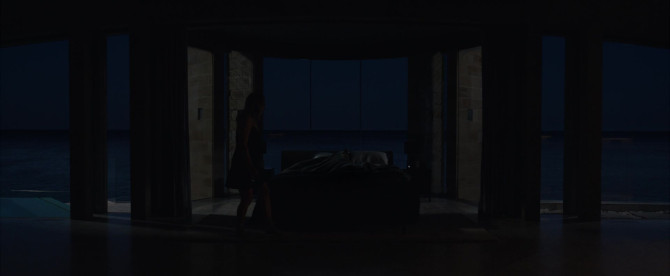A rare example of a remake done right, 2020’s The Invisible Man, written and directed by Leigh Whannell, takes the general idea from the 1933 classic (as well as the 1897 novel by H.G. Wells) and updates it for the twenty-first century, never going too far, giving it a crisp, claustrophobic feeling.
Stuck in a violent, psychologically draining relationship, we are dropped right into the troubled life of Cecilia Kass (Elisabeth Moss), a woman who is trapped under the all-controlling dome of tech wiz millionaire Adrian Griffin (Oliver Jackson-Cohen) – who has hit it big in the field of optics. Disturbingly controlling, his abode, like the overall story, has been updated for the twenty-first century – instead of a gothic castle full of secret passages and torches, it is a sleek, ultra modern, hyper reflective open floor-plan mansion teetering on the edge of the ocean. . . with all of the technology needed to keep the outside world at bay (and the inside guests trapped).
After long and careful planning, Cecilia is finally able to escape – picked up by her helpful but contrary sister Emily (Harriet Dyer). Taken in by a friend, police officer and single father James Lanier (Aldis Hodge), she finds a small sense of safety in this friendly and more homey landscape. She has an especially close bond with his daughter, Sydney (Storm Reid).
Of course, it does not take long for some weird anomalies to pop up – occurrences that only Cecilia ever sees. Believing that it must be her former beau, she learns that he has supposedly committed suicide – and is soon visited by his lackey lawyer brother, Tom (Michael Dorman), who reveals that Adrian has left her five million dollars in trust. . . and they all lived happily ever after – yeah right!
Building this relationship based psychological thriller in a tense, claustrophobic way and then adding the equally intense horror element, The Invisible Man is twice as horrifying for it. Understanding how to create visuals that further the story, Whannell frequently has the camera tracking or panning, moving to eerily empty spaces, or lingering long on a seemingly invisible man after our character has left the frame – a rare and highly effective technique. Giving a look-over-your-shoulder quality to the piece, you can’t help but get involved in this mind-twist mystery – and thankfully, it never devolves into cheap thrills or ridiculous premises. And, as for the visual effects, a combination of old school trickery and modern computer green-screen work, it never looks anything but spectacular – a simply effective trendsetter just like the original 1933 was.
Unluckily hampered in being seen due to the onset of the Covid 19 pandemic. . . I am glad to say that it continues to reach audiences worldwide (though mostly at home now rather than in theatres). A smart, methodical, expertly crafted remake that utilizes its confined setting to set up for a satisfying conclusion, The Invisible Man was thankfully made with a more micro perspective instead of the ridiculously over-reaching and under-baked The Mummy (2017). It is also worth noting that Elisabeth Moss is absolutely superb in this role – allowing us to understand her character’s predicament right off the bat without truly being introduced to her, emoting to empty rooms, and covering an impressive range of emotions, she really is the heart of this production. A last note – if you know the original, keep your eyes peeled for a few cheeky references (including a little cameo from what looks an awful lot like the Invisible Man’s original attire). So, don’t let Covid make this film invisible, though it might make you see double.



